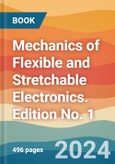Soft electronics systems, which include flexible and stretchable electronics, are an area of technology with the potential to revolutionize fields from healthcare to defense. Engineering for flexibility and stretchability without compromising electronic functions poses serious challenges, and extensive mechanics and engineering knowledge is required to meet these challenges. Mechanics of Flexible and Stretchable Electronics introduces a range of soft functional materials and soft structures and their potential applications in the construction of soft electronics systems. Its detailed attention to the mechanics of these materials and structures makes it an indispensable tool for scientists and engineers at the cutting edge of electronics technology.
Mechanics of Flexible and Stretchable Electronics readers will also find: - A detailed summary of recent advances in the field - Detailed treatment of structures including kirigami, serpentine, wrinkles, and many more - A multidisciplinary approach suited to a varied readership
Mechanics of Flexible and Stretchable Electronics is ideal for electronics and mechanical engineers, solid state physicists, and materials scientists, as well as the libraries that support them.
Table of Contents
Preface xiii
Part I Materials 1
1 Extreme Mechanics of Hydrogels Toward In Situ Hydrogel Bioelectronics 3
Tsz H. Wong, Xuanhe Zhao, and Shaoting Lin
1.1 Introduction 3
1.2 Extreme Properties of Hydrogels by Polymer Network Design 5
1.3 Stretchable Hydrogel Conductors 14
1.4 Electrochemical Hydrogel Biosensors 18
1.5 Flexible Hydrogel Biobattery 20
1.6 Concluding Remarks 23
2 Multiscale Mechanics of Metal Nanowire-Based Stretchable Electronics 37
Shuang Wu and Yong Zhu
2.1 Introduction 37
2.2 Metal NW-Based Flexible and Stretchable Electronics 38
2.3 Mechanics of Individual NWs 39
2.4 Interfacial Mechanics of the NW-Polymer Interface 45
2.5 Mechanical Design of Stretchable Structures 54
2.6 Concluding Remarks 58
3 Liquid Metal-Based Electronics 69
Carmel Majidi
3.1 Introduction 69
3.2 LM Architectures 71
3.3 Mechanics and Modeling 76
3.4 Open Challenges and Future Directions 81
4 Mechanics of Two-Dimensional Materials 87
Olugbenga Ogunbiyi and Yingchao Yang
4.1 Introduction 87
4.2 Nanoindentation Method 90
4.3 AFM-Enabled Nanoindentation 93
4.4 In Situ Indentation in SEM 108
4.5 Micro-/Nano-mechanical Devices 111
4.6 Piezoelectric Tube-Driven Testing in TEM 120
4.7 Bulge Testing 121
4.8 Electrostatic Force Triggered Drum Structure 124
4.9 Phonon Dispersion Measurement 125
4.10 Summary 126
5 Mechanics of Flexible and Stretchable Organic Electronics 139
Abdullah Al Shafe and Brendan T. O'Connor
5.1 Introduction 139
5.2 Mechanical Characterization Methods 140
5.3 Material Design 145
5.4 Device Design 153
5.5 Applications 156
5.6 Conclusion 159
Part II Design and Manufacturing 171
6 Structural Design of Flexible and Stretchable Electronics 173
Zhaoqian Xie, Zichen Zhao, and Raudel Avila
6.1 Introduction 173
6.2 Design of Planar Stretchable and Flexible Structures 174
6.3 Design of Three-Dimensional Flexible Electronic Structures 189
6.4 Design of Protective Structures for Flexible Electronic Devices 193
7 Laser-Based Fabrication Process Development for Flexible and Stretchable Electronics 207
Jung Jae Park, Minwoo Kim, and Seung Hwan Ko
7.1 Introduction 207
7.2 Representative Laser-Based Fabrication Process 208
7.3 Applications Based on Laser Fabrication 211
7.4 Perspectives and Conclusion 225
8 Electrospinning Manufacturing of Stretchable Electronics 235
Yinhui Li, Kan Li, Yunlei Zhou, and YongAn Huang
8.1 Background 235
8.2 High-Precision Manufacturing 236
8.3 Electrospinning Stretchable Structure 243
8.4 Application in Stretchable Electronics 247
8.5 Conclusions 254
9 Mechanics-Guided 3D Assembly of Flexible Electronics 265
Guoquan Luo, Jianzhong Zhao, Xu Cheng, and Yihui Zhang
9.1 Introduction 265
9.2 Design Strategies of Mechanics-Guided Assembly 266
9.3 Mechanics Modeling and Analyses of the 3D Assembly 275
9.4 Applications of 3D Flexible Electronics 284
9.5 Concluding Remarks 287
10 Harnessing Wrinkling and Buckling Instabilities for Stretchable Devices and Healthcare 293
Yao Zhao, Fangjie Qi, Haoze Sun, Yanbin Li, Haitao Qing, and Jie Yin
10.1 Introduction 293
10.2 Structural Designs and Mechanics 294
10.3 Applications in Stretchable Devices 300
10.4 Applications in Healthcare 306
10.5 Conclusion and Outlook 311
Part III Applications 319
11 Spherical Indentation Behavior of Soft Electronics 321
Changxian Wang, Zequn Cui, and Xiaodong Chen
11.1 Spherical Indentation of the Semi-infinite Solid 321
11.2 Applications in a Force-Softness Bimodal Sensor Array for Human Body Feature Identification 328
11.3 Applications in a Self-Locked Young’s Modulus Sensor for Quantifying the Softness of Swollen Tissues in the Clinic 336
11.4 Conclusions 343
12 Mechanics of Wet Adhesion 345
Jiawei Yang and Ruobing Bai
12.1 Introduction 345
12.2 Characterization of Adhesion 346
12.3 General Principles for StrongWet Adhesion 347
12.4 Methods for StrongWet Adhesion 354
12.5 Mechanics ofWet Interfaces 357
12.6 Summary and Outlook 362
13 Electromechanics of Soft Resistive and Capacitive Tactile Sensors 373
Zhengjie Li, Sangjun Kim, Zheliang Wang, Zhengtao Zhu, and Nanshu Lu
13.1 Introduction 373
13.2 Resistive Tactile Sensors 378
13.3 Capacitive Tactile Sensors 399
13.4 Resistive-Capacitive Hybrid Response Tactile Sensors 415
13.5 Conclusion and Outlook 418
14 Active Mechanical Haptics Constructed with Curved Origami 431
Zhuang Zhang and Hanqing Jiang
14.1 Introduction 431
14.2 Stiffness Tuning via Curved Origami 432
14.3 Theoretical Modeling and Analysis of Curved Origami 434
14.4 Closed-Loop Design and System Integration of Origami 438
14.5 In-hand Haptic Device 440
14.6 Stiffness Perception via Active Pressing 443
14.7 Body-Centered Stepping Device 444
14.8 Whole-Body Stiffness Perceptions 447
14.9 Discussion 448
15 Mechanics of Transient Electronics 453
Ankan Dutta and Huanyu Cheng
15.1 Introduction 453
15.2 Hydrolysis of Semiconducting Materials 455
15.3 Model of Reactive Diffusion for Transient Materials 457
15.4 Dissolution of the Device with Bi-layered Structures 461
15.5 Conclusion 467
Acknowledgments 468
References 468
Index 473








